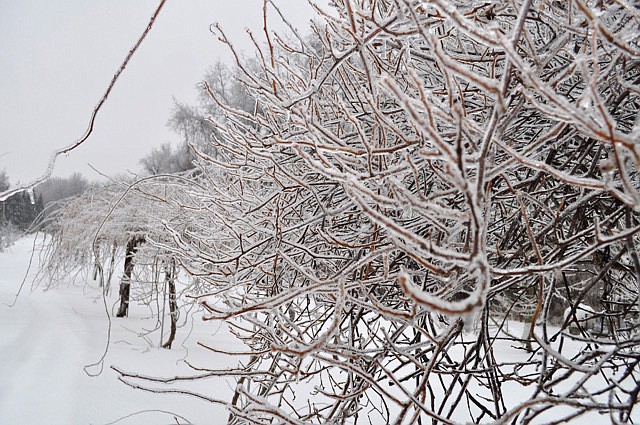Since they can't don gloves and a scarf or shiver to keep warm, it's a wonder that trees, vines and shrubs don't freeze to death in winter.
Sometimes, of course, they do. But usually that happens to garden and landscape plants pushed to their cold limits, not to naturally cold-hardy plants or plants in their native habitats.
Think about it: Water freezes at 32 degrees Fahrenheit - not a particularly cold temperature for a winter night - and plants contain an abundance of water. Water expands when it freezes, so you can imagine the havoc that would be wreaked if water-filled plant cells froze and burst. But adapted trees, vines and shrubs survive temperatures well below freezing each winter.
Water, whether in a plant cell or a glass, does not necessarily freeze as soon as the temperature drops to 32 degrees. To freeze, water molecules need something to group around to form ice crystals, a so-called nucleating agent. Without it, water will "supercool," remaining liquid down to about minus 40 degrees. All sorts of things can serve as nucleating agents - bacteria, for instance.
Plants have another trick for dealing with the cold: letting water freeze only outside their cells, where the ice doesn't do damage. Cell membranes are permeable to water, so as temperatures drop, ice crystals that form outside plant cells grow with the water they draw out of the cells. With increasing cold, a plant becomes threatened more by dehydration than by freezing.
Cell sap is not pure water; in it are dissolved various substances. You may recall something called freezing-point depression from high school chemistry: Basically, whenever you dissolve something in water, you lower the resulting solution's freezing point. So as water is drawn out of the liquid of plant cells, the liquid within the cells becomes more and more concentrated in whatever was dissolved in it. As a result, the temperature at which the cellular liquid freezes keeps dropping.
So the plant is not a passive player in this cold story. In preparing for cold, cell walls strengthen, cell sap becomes more sugary and the permeability of cells to water is altered. Here's where we gardeners can step in: Light supplies the energy that plants need to prepare for cold, so we can make sure to site and prune plants so they get adequate light. Fruits are energy sinks, so we can also make sure not to let a plant bear too heavy a crop of fruit, especially if the plant is borderline cold-hardy.
In addition to preparing plants for the cold, we can play around with microclimate, the climate right around a plant. Plants near south-facing walls, near paving, or sheltered from north winds keep a few degrees warmer than their more exposed counterparts. Swaddling a plant for winter, as is often done with roses, does nothing for its appearance but does give it a few extra degrees of warmth. A plant needs to experience some cold before it can prepare itself for cold, so never swaddle a plant too soon in autumn.
Unfortunately, all this fiddling to help a plant through winter pales in the face of genetics. The most that we gardeners can do to help trees and shrubs face winter is to plant those that naturally tolerate the coldest temperatures that winter is apt to serve up.
The U.S. Department of Agriculture Plant Hardiness Zone Map (http://planthardiness.ars.usda.gov/PHZMWeb) gives an idea of the average extreme lowest temperature for each region of the country. Most of the Chattanooga area is in zone 7A, where the lowest extreme temperature is listed as 0-5 degrees. Actual coldest temperature will, of course, vary from year to year and be influenced by microclimates at various places around your yard.
